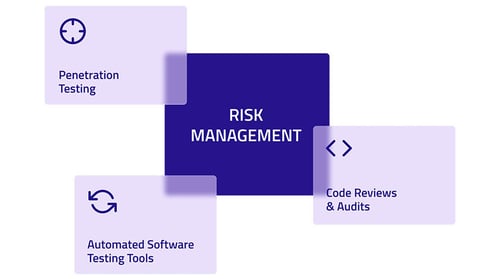If you’re here, you know this already: security testing isn’t just another checkbox in software development—it’s a fundamental aspect of the development process that can make or break your application’s reliability and your company’s financial prosperity and reputation.
Think of security testing as ensuring your software stands up to potential attacks and keeps data safe. As cyber threats become more sophisticated, embracing a comprehensive approach to security testing is mission-critical. Even non-malicious security flaws can cause devastating roll-on effects. Anybody ever heard of CrowdStrike? Yep, that little $5.4 billion hiccup.
In a world where even your refrigerator is connected to your smartwatch, security testing has become more crucial than ever. According to IBM’s Cost of a Data Breach report, the global average data breach cost in 2024 is USD $4.88M—a 10% increase over last year and the highest total ever.
And it's not only about finding flaws in your code; it's about fortifying your software against increasingly clever attacks on your application and those connected to it.
By embedding multiple security testing methods early in your development process (or shifting your testing left - we’ll talk more about that later), you’re not just reacting to problems but proactively building resilience into your software.
Understanding Security Testing in Software Development
What is Security Testing?
Security testing is much like giving your software a safe but rigorous workout to ensure it can handle the stresses of real-world threats. It involves evaluating an application’s defenses to identify vulnerabilities – before attackers can exploit them. The main goal is to ensure that your software can protect user and company data, maintain functionality, and resist breaches effectively.
The main objectives of security testing include finding vulnerabilities, assessing potential risks, and verifying that the application meets security standards, depending on the industry in which you’re operating. Above all, the aim is to identify weaknesses as early as possible so you can address them before they become serious issues.
Why is it Important?
Security testing is essential in software development because it helps to:
- Protect sensitive data, so sensitive information, such as personal user data and financial details, is safeguarded against unauthorized access
- Maintain user trust and confidence by preventing security vulnerabilities that could damage the software and your organisation's reputation, maintaining user trust and confidence in the product
- Comply with regulations by helping developers adhere to legal and industry-specific regulations and standards, which often require stringent security measures to protect user data (for example, software testing in the medical industry)
- Prevent financial loss by identifying and mitigating security risks like cyber-attacks, ransom demands, data breaches, and associated legal costs
- Ensure system integrity and availability by preventing attacks compromising system availability, ensuring that your product functions correctly and remains accessible to your users
Identifying Risks and Vulnerabilities
Before you can fix security problems, you need to know where they are. Identifying risks early in the development process helps teams focus on the most critical risks and act more proactively – rather than scrambling to fix issues after it’s too late.
Software is full of potential pitfalls—SQL injections, Cross-Site Scripting (XSS), and broken authentication mechanisms, just to name a few. These vulnerabilities can lead to significant security breaches if not adequately addressed. Knowing what to look for helps prioritize your security efforts and focus on the most critical issues.
Developers use various methods to uncover vulnerabilities, including static and dynamic analysis, manual testing, and automated scanners. Static analysis examines the source code for flaws, while dynamic analysis tests the software in real time. Combining these methods helps ensure that all potential vulnerabilities are identified and addressed.
How to do Software Risk Management Effectively
Risk management aims to protect your software from potential threats, ensuring it remains functional and secure – which involves regular assessments, ongoing monitoring, training, and updating risk management strategies as needed.
Taking a multi-pronged approach to risk mitigation will provide your applications (and, therefore, your business) with the broadest coverage. In this section, we’ll talk briefly about three approaches:
Code Reviews and Audits
Code reviews and audits involve team members reviewing each other’s code with a fine-toothed comb to identify bugs, security vulnerabilities, and adherence to coding standards. Although these reviews create better code quality and team knowledge, they can be time-consuming. Audits by external experts or specialized teams delve deep into the codebase for a more comprehensive evaluation, ensuring compliance with security standards and regulations.
Penetration Testing
Another critical method is penetration or pen testing, where ethical hackers simulate real-world attacks to uncover security weaknesses. This approach provides valuable insights into potential vulnerabilities, though it requires skilled professionals and can be costly.
Automated Software Testing Tools
Complementing the above methods are automated software testing tools that continuously scan the codebase for known issues. These tools are fast, scalable, and integrate well into CI/CD pipelines but may produce false positives or miss particular vulnerabilities.
Benefits of Using Automated Software Testing Tools
While automated testing tools require time to set up and learn, they don't take up developer time once they’re up and running. They continuously operate and execute reliably reproducible tests. Manual methods like code review, on the other hand, can yield different results depending on the day or the individual. Plus, automated software testing tools are unimaginably fast. They can check numerous cases simultaneously and be reconfigured according to central standards.
For instance, if a new SQL injection method is discovered, automated tools can quickly adapt to detect it. If you were operating with only manual code review, it would require training all reviewers on the new threat, which could take months to implement – far too late in the cyber security world.
With automated tools, you simply adjust the configuration, and the tools immediately incorporate the new information. This ensures consistent quality and efficiency, as the tools continuously perform their tasks without needing a manual review. This proactive approach helps maintain code adherence to established standards efficiently and effectively.
Error Handling, Fail-safes and Documentation
Why Error Handling is Crucial
Errors are an unavoidable part of building products. Yet, our reaction to them can be the difference between minutes vs. days of downtime or hundreds vs. millions of dollars. So, it makes sense that robust error-handling practices are vital for maintaining software security. Properly managing errors ensures that unexpected issues don’t compromise data integrity or system functionality, that mistakes are appropriately documented, and that management plans are clear for all stakeholders.
Fail-safes
Fail-safes are mechanisms designed to manage errors and keep the system running smoothly. Techniques such as exception handling, error logging, and monitoring are essential for detecting and addressing issues before they escalate.
Documentation
Documentation is one of the essential parts of software development (which is worse: bad documentation or no documentation? Tell us in the comments!), and this is no different in the software testing space. Documentation for software testing generally contains a few main objects:
- Documentation of the planning of software test cases and overall testing strategy
- Documentation of the test cases and scripts themselves, how they’re constructed and how to reproduce them (either manually or using automated testing software)
- Documentation of test results (psst: we’ve got a solution for that, too)
The Shift-left Approach to Software Security
The shift-left approach involves integrating security testing early in the development process.
By addressing security from the beginning, developers can identify and resolve vulnerabilities sooner, enhancing the overall quality and security of the software. This proactive approach ensures that security is integral to the development lifecycle.
To implement a Shift-Left strategy, involve security experts early, integrate security testing into CI/CD pipelines, and continuously assess and address security risks. Some development teams go so far as to adopt test-driven development (TDD) and write tests before they even write the piece of code.
An Alternative Approach: Security by Design
Security by design is straightforward in theory: integrate security requirements from the start. It sounds simple, but development hasn’t always been done this way. Traditionally, developers would create code based on a list of requirements and add security measures later.
With security by design, security is included in the initial list of requirements before the development work starts. For instance, if you're developing a system handling customer data, you should immediately embed security measures like:
- Preventing data leaks
- Restricting data access to authorized users
- Encrypting data
But if it’s so simple, why don’t all developers do it?
Developers are highly skilled and more than capable, but they often face heavy workloads and tight deadlines, leaving little room for considering broader security implications.
Security requirements can be more complex and abstract than technical ones, requiring a wider perspective on how the system will function within a larger network and its potential vulnerabilities.
This is where automated tools can help. These tools can simplify the process by providing immediate feedback on potential security issues and pinpointing specific lines of code that need attention. Instead of overwhelming developers with the big picture, these tools break down security needs into manageable pieces, helping developers understand and address them effectively without adding to their workload.
Summing it up: The Importance of Software Security
Developers strive to create secure software, but the complexity and potential for errors make it a constant battle. Security breaches can have significant consequences, such as data leaks or system vulnerabilities, leading to public outcry and legal repercussions. While minor system crashes can be rebooted and fixed, security issues often have more severe and far-reaching impacts.
Security testing is more than a technical necessity; it’s crucial to ensuring that software remains reliable and secure. By adopting a comprehensive approach to security testing and integrating it early in your development process, you can build more resilient applications and protect against potentially devastating threats.
.webp)



